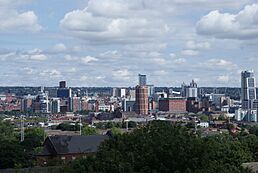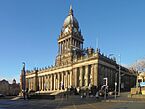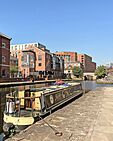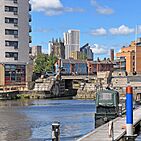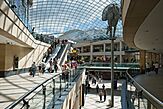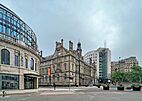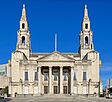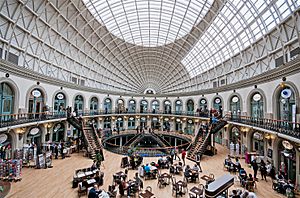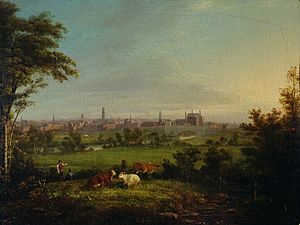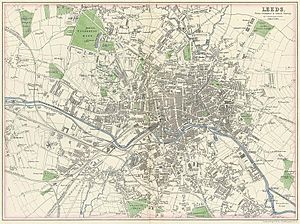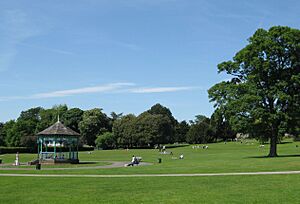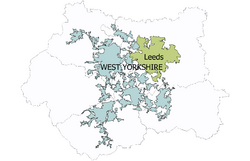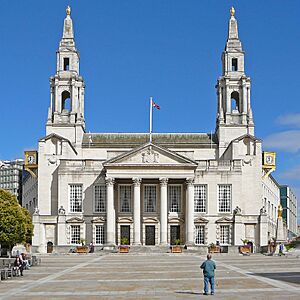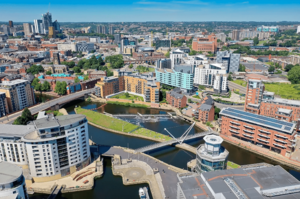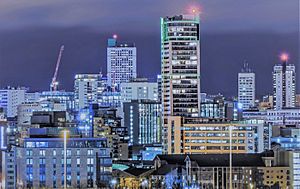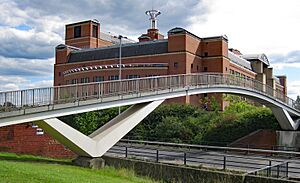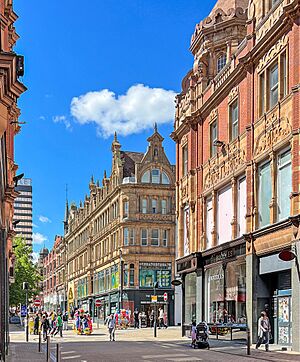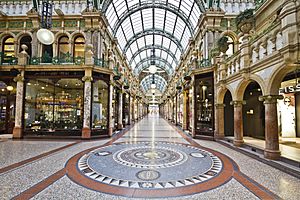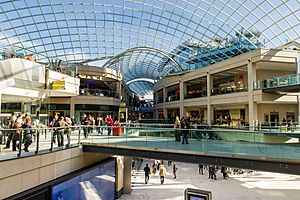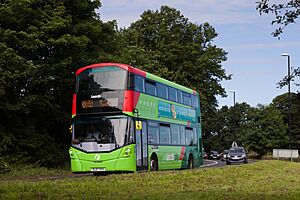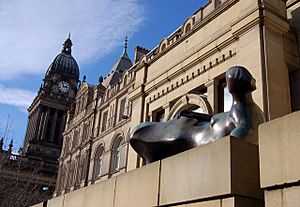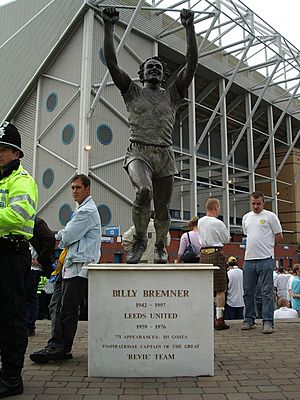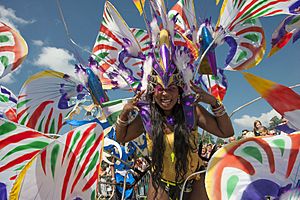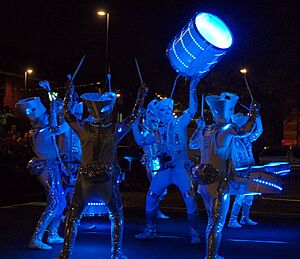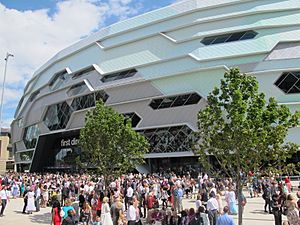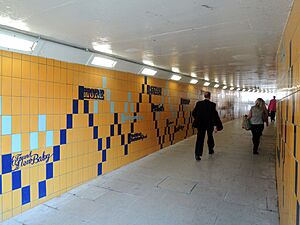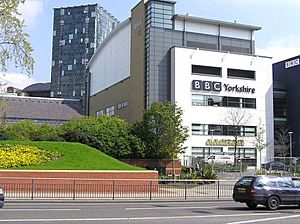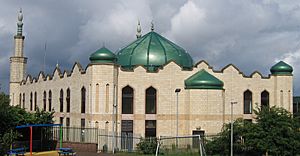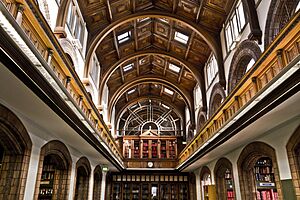Leeds facts for kids
Quick facts for kids Leeds |
|
|---|---|
| City | |
|
County Arcade of the Victoria Quarter
Granary Wharf
Trinity shopping centre
Civic Hall
|
|
 Coat of arms |
|
| Area | 111.6 km2 (43.1 sq mi) |
| Population | 536,280 (2021 estimate; ONS) |
| • Density | 4,805/km2 (12,440/sq mi) |
| OS grid reference | SE299339 |
| Metropolitan borough | |
| Metropolitan county | |
| Region | |
| Country | England |
| Sovereign state | United Kingdom |
| Post town | LEEDS |
| Postcode district | LS1-20, LS25-27 |
| Dialling code | 0113 |
| Police | West Yorkshire |
| Fire | West Yorkshire |
| Ambulance | Yorkshire |
| EU Parliament | Yorkshire and the Humber |
| UK Parliament |
|
Leeds is a big city in West Yorkshire, England. It's the largest city in Yorkshire and the main hub for the City of Leeds Metropolitan Borough. This makes it the second most populated area in the United Kingdom. Leeds is built around the River Aire and sits near the Pennines mountains.
Long ago, in the 13th century, Leeds was a small village. By the 16th century, it became a market town. It grew a lot in the 17th and 18th centuries, becoming a major place for making and trading goods, especially wool. During the Industrial Revolution, Leeds became a busy factory town, known for its flax industry, metal factories, engineering, and printing. It also became a great place for shopping, with many old Victorian era shopping arcades still around today.
Leeds officially became a city in 1893. Over the next century, it grew even more, taking in nearby villages and becoming bigger than York. Today, Leeds has a very strong and varied economy. It has seen the fastest growth in private sector jobs of any UK city. Leeds is home to over 109,000 companies and creates 5% of England's total economic output. It's also known as a "high sufficiency city" globally. Leeds is seen as the cultural, financial, and business heart of the West Yorkshire Urban Area.
The city has four universities, which means it has the fourth largest student population in the country. This has made Leeds a lively place with lots of nightlife, sports, and cultural activities. You can find classical and popular music festivals, and many museums here. Leeds is well-connected by major roads like the M1, M62, and A1(M). Its railway station is one of the busiest in Northern England. The city has a population of 536,280, and the wider Leeds district has about 812,000 people.
Contents
- Exploring Leeds: A Vibrant City
- Leeds's Amazing History
- Leeds's Location and Landscape
- People and Communities in Leeds
- How Leeds is Governed
- Leeds's Economy and Business
- Famous Places in Leeds
- Getting Around Leeds
- Learning and Museums in Leeds
- Culture and Fun in Leeds
- Media in Leeds
- Sports in Leeds
- Religions in Leeds
- Public Services in Leeds
- Freedom of the City of Leeds
- See also
Exploring Leeds: A Vibrant City
Leeds's Amazing History
How Leeds Got Its Name
The name Leeds comes from an old word, *Lātēnses. This word meant "people of the fast-flowing river," referring to the River Aire. This name was first used for the forest area that covered most of the ancient kingdom of Elmet. This kingdom existed from the 5th to the early 7th century.
An old historian named Bede wrote about a place called Loidis in his book, Ecclesiastical History of the English People. People from Leeds are sometimes called Loiners, but no one is quite sure where that word came from. Another term, Leodensian, comes from the city's Latin name.
Growing Through the Ages
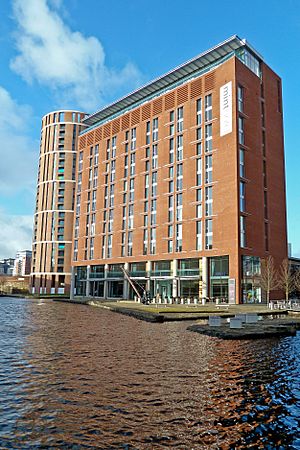
Leeds started as a market town in the Middle Ages, mainly for farming. Before the Industrial Revolution, it became a key place for making woollen cloth. In 1770, Leeds handled one sixth of England's export trade. The city grew even faster when canals were built, like the Aire and Calder Navigation in 1699 and the Leeds and Liverpool Canal in 1816.
Factories for making tools and machines for the textile industry quickly grew into many different types of engineering. The first railway in Leeds, the Leeds and Selby Railway, opened in 1834. This helped Leeds connect to national markets and to ports like Liverpool and Hull, making it easier to trade with other countries. Leeds also kept its focus on trading farm goods, and the Leeds Corn Exchange opened in 1864.
From around 1790, many factories were built in Leeds, especially for wool and flax. By 1914, manufacturing had spread to printing, engineering, chemicals, and clothing. During the 1930s, manufacturing slowed down, but it picked up again during the Second World War to make military uniforms. However, by the 1970s, the clothing industry faced tough competition from abroad and declined.
Today, Leeds has changed from an industrial city to a modern business hub. It's a major centre for telephone banking and has seen growth in corporate and legal jobs. More wealth in the city has also led to a growing retail sector, including luxury goods. The Leeds City Region Enterprise Zone was started in 2012 to help new businesses grow.
How Leeds's Suburbs Grew
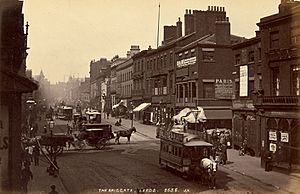
In 1801, many people in Leeds lived outside the main town area. Health problems like Cholera outbreaks in 1832 and 1849 made city leaders improve water and sewage systems. New reservoirs were built north of Leeds to provide clean water.
Areas like Holbeck and Hunslet grew a lot between 1801 and 1851. As these areas became industrial, middle-class families moved to new housing areas. Land south of the river was mainly used for factories and small workers' homes. Laws were passed to improve the quality of working-class housing.
By 1858, Holbeck and Leeds had become one continuous built-up area. As pollution increased, wealthier residents moved away from the industrial areas to places like Headingley and Chapel Allerton. The introduction of electric trams also helped people move further out, leading to growth in areas like Roundhay. The city also took over gas and electricity supplies, making them cheaper for homes and providing street lighting.
After the Second World War, many old, poor-quality houses were replaced with new council homes and flats. Private builders also built many new houses, creating suburbs like Gledhow and Roundhay. Today, Leeds has invested a lot in making the city centre modern and attractive, with many new luxury apartments.
Leeds's Location and Landscape
Leeds is located on the River Aire, in a narrow part of the Aire Valley, near the Pennines mountains. The city centre is about 63 metres (206 feet) above sea level. The wider Leeds district ranges from 340 metres (1,115 feet) high in the west to about 10 metres (33 feet) low in the east where the rivers Aire and Wharfe cross the boundary. The main part of Leeds is a continuous built-up area that includes towns like Pudsey and Morley.
Leeds is one of the largest local authority districts in the UK by population and area. It stretches about 24 kilometres (15 miles) from east to west and 21 kilometres (13 miles) from north to south. Over 65% of the Leeds district is green belt land, which means it's protected from too much building. The city centre is less than 32 kilometres (20 miles) from the beautiful Yorkshire Dales National Park.
The land in central Leeds is mostly urban, with buildings everywhere. However, the city also has many green spaces. The northern boundary of Leeds follows the River Wharfe for several miles. The LS postcode area covers most of the Leeds district, but some nearby towns like Otley and Wetherby have their own post towns.
Leeds's Green Spaces
Leeds has a special "green belt" area around it. This is to stop the city from spreading too much, to protect smaller towns nearby, and to keep the countryside beautiful. Over 60% of the Leeds district is green belt land. This means there are strict rules about what can be built there.
The green belt also encourages people to enjoy nature. It includes places like Temple Newsam Park, Rothwell Country Park, Middleton Park, and the ruins of Kirkstall Abbey. These areas offer great places for recreation and enjoying the outdoors.
Leeds's Weather
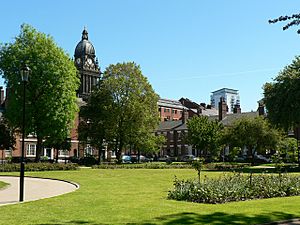
Leeds has an oceanic climate, which means it has mild summers and chilly, cloudy winters. It sometimes snows and freezes in winter. July is usually the warmest month, with an average temperature of 16°C (61°F). January is the coldest, with an average of 3°C (37°F). Very hot days (above 30°C/86°F) or very cold days (below -10°C/14°F) are rare but can happen.
The highest temperature ever recorded in Leeds was 34.4°C (93.9°F) in August 1990. Because Leeds is on the eastern side of the Pennines, it's one of the driest cities in the UK, with about 660 mm (26 inches) of rain each year. While extreme weather is rare, thunderstorms, blizzards, strong winds, and even tornadoes have happened. The last reported tornado was in 2006, which caused trees to fall and train delays.
| Climate data for Leeds Bradford, extremes 1985–2003 | |||||||||||||
|---|---|---|---|---|---|---|---|---|---|---|---|---|---|
| Month | Jan | Feb | Mar | Apr | May | Jun | Jul | Aug | Sep | Oct | Nov | Dec | Year |
| Record high °C (°F) | 14.3 (57.7) |
17.5 (63.5) |
21.2 (70.2) |
26.1 (79.0) |
28.5 (83.3) |
31.7 (89.1) |
31.1 (88.0) |
34.4 (93.9) |
28.2 (82.8) |
24.5 (76.1) |
17.3 (63.1) |
15.3 (59.5) |
34.4 (93.9) |
| Mean daily maximum °C (°F) | 5.8 (42.4) |
5.9 (42.6) |
8.7 (47.7) |
11.3 (52.3) |
15 (59) |
18.2 (64.8) |
19.9 (67.8) |
19.9 (67.8) |
17.3 (63.1) |
13.4 (56.1) |
8.8 (47.8) |
6.7 (44.1) |
12.6 (54.6) |
| Daily mean °C (°F) | 3.1 (37.6) |
3.1 (37.6) |
5.2 (41.4) |
7.2 (45.0) |
10.3 (50.5) |
13.4 (56.1) |
15.2 (59.4) |
15.2 (59.4) |
13.0 (55.4) |
9.9 (49.8) |
5.9 (42.6) |
4.0 (39.2) |
8.8 (47.8) |
| Mean daily minimum °C (°F) | 0.3 (32.5) |
0.2 (32.4) |
1.6 (34.9) |
3.1 (37.6) |
5.5 (41.9) |
8.5 (47.3) |
10.4 (50.7) |
10.5 (50.9) |
8.7 (47.7) |
6.3 (43.3) |
2.9 (37.2) |
1.2 (34.2) |
4.9 (40.9) |
| Record low °C (°F) | −7.9 (17.8) |
−8.5 (16.7) |
−6.5 (20.3) |
−2.1 (28.2) |
0.3 (32.5) |
2.5 (36.5) |
6.4 (43.5) |
5.5 (41.9) |
2.1 (35.8) |
−3.5 (25.7) |
−5.5 (22.1) |
−7.9 (17.8) |
−8.5 (16.7) |
| Average precipitation mm (inches) | 61 (2.4) |
45 (1.8) |
52 (2.0) |
48 (1.9) |
54 (2.1) |
54 (2.1) |
51 (2.0) |
65 (2.6) |
57 (2.2) |
55 (2.2) |
57 (2.2) |
61 (2.4) |
660 (25.9) |
| Average precipitation days | 17.5 | 14.2 | 14.8 | 13.5 | 13.7 | 12.2 | 11.7 | 13.2 | 12.9 | 15.1 | 16.5 | 17.0 | 172.3 |
People and Communities in Leeds
Leeds's Population and Diversity
Leeds is the main city in the City of Leeds area, which also includes towns like Horsforth, Morley, and Otley. The wider Leeds City Region has over 3 million people, making it the second most populated city region in the UK, after London.
In 2011, Leeds was named one of the top "cities to watch" in a report. It has a good average income and is less deprived than many other large UK cities.
|
Leeds urban subdivision within the West Yorkshire urban area |
||||
| 2021 UK Census |
Leeds USD |
Leeds district |
West Yorks UA |
England |
|---|---|---|---|---|
| Population | 515,947 | 811,953 | 2,351,582 | 56,489,840 |
| White | 71.2% | 79.0% | 76.6% | 81.0% |
| Asian | 13.1% | 9.7% | 15.9% | 9.6% |
| Black | 8.3% | 5.6% | 3.1% | 4.2% |
| Source: Office for National Statistics | ||||
In 2011, the main urban part of Leeds had a population of 474,632. It covers about 112 square kilometres (43 square miles). This area is connected to nearby towns like Garforth and Pudsey. About 63% of the wider Leeds district's population lives in this urban area, even though it only takes up 21% of the total land.
Leeds is a very diverse city, with people from over 75 different ethnic backgrounds. About 11.6% of the population are from ethnic minority groups. According to the 2011 UK Census, 85% of people were White, 2.7% were of mixed race, 7.7% were Asian, and 3.5% were Black. Leeds has welcomed people from many countries, including Zimbabwe, Iran, India, and Nigeria. Large Pakistani communities live in areas like Gipton and Harehills, and Chapel Allerton is known for its large Caribbean community.
How Leeds is Governed
The City of Leeds is the local government area for Leeds. The main authority is Leeds City Council, which has 99 councillors. These councillors are elected every three out of four years. The council is currently led by the Labour party. Since West Yorkshire doesn't have a county council, Leeds City Council provides most local services for the city.
Most of the Leeds district is an "unparished area," meaning there isn't a smaller local government level. However, there are 31 civil parishes outside this area, which have their own local councils. These councils handle some smaller tasks for their communities.
Leeds is represented by ten Members of Parliament (MPs) in the UK Parliament. These MPs represent different areas of Leeds and some shared constituencies with nearby regions.
Leeds's Economy and Business
Leeds has the most varied economy of all major UK cities. It has seen the fastest growth in private sector jobs and has more private sector jobs than public sector jobs compared to other large UK cities. At the start of 2015, Leeds had 480,000 jobs. Many jobs are in public services, banking, finance, insurance, and retail. Leeds is especially strong in banking, finance, and insurance. The city centre alone has 130,100 jobs, which is 31% of all jobs in the wider district.
In 2011, the financial and services industry in Leeds was worth £2.1 billion, making it the fifth largest in the UK. Industries like retail, call centres, offices, and media have helped the city's economy grow quickly. Leeds is also home to the only branch office of the Bank of England outside London. The entire Leeds City Region generates a £56 billion economy.
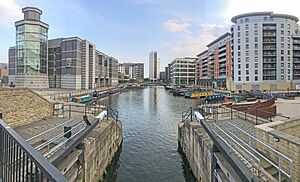
Key industries in Leeds include finance, retail, tourism, construction, manufacturing, and creative and digital businesses. Leeds is ranked as a "High Sufficiency" city globally. Today, Leeds is the largest legal and financial centre outside London. The financial and insurance services industry alone contributes £13 billion to the city's economy.
New office buildings have been built, especially south of the River Aire. Between 1999 and 2008, £2.5 billion was spent on property development in central Leeds. Leeds has also been a place of innovation, with the oldest surviving film, Roundhay Garden Scene (1888), and the invention of soda water in 1767.
Many big companies are based in Leeds, such as William Hill, Channel 4, Asda, and Leeds Building Society. Other large companies like KPMG and Aviva also have a big presence here. Leeds is also home to a large Department for Work and Pensions office.
Leeds is the UK's third largest manufacturing centre. About 50% of the UK's manufacturing businesses are within a two-hour drive of Leeds. Around 1,800 manufacturing firms employ 39,000 people in the city. Important manufacturing areas include engineering, printing, food and drink, chemicals, and medical technology. The city also has a strong creative industry, especially in digital gaming, with studios like Activision and Rockstar Leeds. In 2009, Leeds was the first city outside London to host the Eurogamer Expo.
Finance in Leeds
Leeds is the biggest centre outside London for financial and business services. This sector is expected to grow a lot in the next ten years. More than 30 national and international banks have offices in Leeds, including a branch of the Bank of England.
Leeds is also a key place for different types of finance, like venture capital (money for new businesses). YFM Equity Partners, a venture capital provider founded in Leeds, is now the UK's largest. The National Wealth Fund, which helps economic growth across the UK, is also based in Leeds.
Law in Leeds
Around 150 law firms operate in Leeds, employing over 6,700 people. Experts say Leeds has a very strong and competitive legal market, second only to London. Leeds is known for its special legal skills in areas like corporate finance, business restructuring, and international trade. The opening of an Administrative Court in Leeds in 2009 made Leeds even more important as a legal centre in the UK.
Tourism and Leisure in Leeds
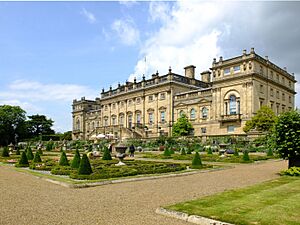
Tourism is a big part of Leeds's economy. In 2009, Leeds was the eighth most visited city in England by UK visitors and the 13th most visited by international visitors. Day visitors bring in over £654 million to the local economy each year. In a 2017 survey, Leeds was ranked 6th among the best UK cities for visitors.
In 2016, Leeds had 27.29 million tourist visits, bringing in over £1.6 billion for the city. This was a big increase from previous years. The tourism industry supports over 19,000 full-time jobs in Leeds.
Public Services in Leeds
About 108,000 people in Leeds work in the public sector, which is 24% of all workers. The biggest employers are Leeds City Council, with 33,000 staff, and the Leeds Teaching Hospitals NHS Trust, with 14,000 staff.
Leeds is a major centre for public health organizations. The Department of Health and Social Care, NHS England, and Public Health England all have large offices here. Europe's largest teaching hospital is also in Leeds, and it's home to the Yorkshire Cancer Centre, the biggest of its kind in Europe.
Other important government offices in Leeds include the Department for Work and Pensions and HM Revenue and Customs. The British Library also has a large site in Leeds.
Shopping in Leeds
The city centre has a large area just for pedestrians, making it easy to walk around. Briggate is the main shopping street, where you can find many popular British stores like Marks & Spencer and Harvey Nichols. Many companies have several stores in Leeds.
Leeds is home to one of the largest indoor markets in Europe, Leeds Kirkgate Market. This market was renovated between 1987 and 1995, keeping its historical look while adding modern shopping features. It was even given a special Grade I listing for its design.
Every year, Leeds hosts a German Christmas Market ("Christkindelmarkt") in Millennium Square. It usually runs from early November to mid-December. Leeds is a major shopping destination for the whole Yorkshire and Humber region, with people spending £1.93 billion here annually.
There are many indoor shopping centres in the city centre, including the Merrion Centre, St John's Centre, The Light, the Corn Exchange, Trinity Leeds, and Victoria Gate. In total, Leeds City Centre has over 1,000 shops.
The Victoria Quarter is famous for its luxury shops and amazing architecture. It has 70 stores, including Louis Vuitton and Harvey Nichols, located in two old Victorian arcades and a new arcade with the largest stained glass roof in Britain.
The White Rose Shopping Centre is located in the Churwell area of Leeds. It opened in 1997 and has over 100 high street stores. On March 21, 2013, a large new shopping and leisure complex called Trinity Leeds opened in the city centre. It covers old arcades and is a very modern shopping space. On October 20, 2016, Victoria Gate shopping centre opened, with John Lewis as its main store. Many of the shops in Victoria Gate were new to Leeds outside of London.
Famous Places in Leeds
Leeds has many interesting natural and man-made landmarks. Natural spots include the rocky Otley Chevin and the Fairburn Ings RSPB reserve. The city's parks, like Roundhay and Temple Newsam, are cared for by the council for everyone to enjoy. In the city centre, you can find open spaces like Millennium Square, City Square, and Victoria Gardens. Victoria Gardens is also home to the city's main war memorial.
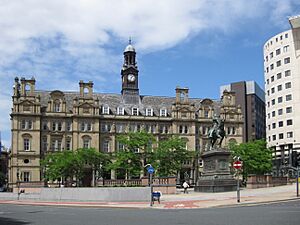
Important buildings in Leeds include Morley Town Hall and the impressive Leeds Town Hall, Corn Exchange, and Leeds City Museum, all designed by architect Cuthbert Brodrick. The two white buildings that stand out in the Leeds skyline are the Parkinson building at Leeds University and the Civic Hall, which has golden owls on top of its twin spires.
Buildings like Armley Mills, Tower Works, and Temple Works remind us of the city's industrial past. The ruins of Kirkstall Abbey show the beauty of old Cistercian architecture. Important churches include Leeds Minster, St George's Church, and Leeds Cathedral.
Leeds is one of the few UK cities outside London with many high-rise buildings. Bridgewater Place, also known as The Dalek, is 112 metres (367 feet) tall and was the region's tallest building until Altus House was completed in 2021. You can see it from miles around. Other tall buildings include the 37-storey Sky Plaza and the 38-storey Altus House. Sports fans will know Elland Road (football stadium) and Headingley Stadium (cricket and rugby stadium).
Getting Around Leeds
Leeds has a great network of roads, buses, and trains. West Yorkshire Metro helps to plan and develop public transport in the area.
The city has good train and road connections to the rest of the country. Leeds railway station is one of the busiest in Britain. Major motorways like the A1(M), M1, and M62 connect to Leeds. The city also has its own airport, Leeds Bradford Airport. There have been many ideas to improve public transport in Leeds over the years, including plans for an underground system and a tram system, but these were cancelled.
In June 2019, Boris Johnson said it was "madness" that Leeds didn't have a metro system. In December 2019, he promised to fix this. Plans are now in place to improve public transport, including upgrades to trains, buses, and cycle lanes. A new tram system for the city was announced in 2023.
Roads and Buses
Leeds is where many important roads start, like the A62 and A64. The M1 and M62 meet south of Leeds, and the A1(M) passes to the east. The M621 takes traffic into central Leeds. The Leeds Inner Ring Road has parts that are like a motorway, and the city also has an outer ring road. Part of the city centre is just for walking, with a one-way loop road around it.
Air quality in Leeds was a concern in 2019. Neville Street, near the railway station, was measured as one of the most polluted streets outside London. A Clean Air Zone was planned for north Leeds and the city centre to charge older, more polluting vehicles. However, this plan was cancelled in 2020 because air quality had improved.
Leeds City bus station has long-distance bus services to nearby towns and cities. The main bus companies are First Leeds and Arriva Yorkshire. You can also take buses to Harrogate, Ripon, Shipley, and even Scarborough. There are also Flyer services to Leeds Bradford Airport. In March 2024, it was announced that buses in Leeds will be run by the public sector.
Cycling in Leeds

An electric bicycle rental scheme called Leeds City Bikes started in September 2023. You can pick up bikes from special bays around the city centre.
Trains in Leeds
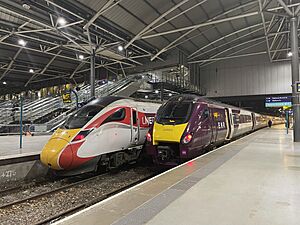
In 2017, Leeds had the third busiest railway station in the UK outside of London. From Leeds railway station, trains run to Leeds's suburbs, the wider area, and other parts of the country. The station has 18 platforms, which is more than any other station outside London.
The Leeds area has 16 railway stations. There are plans for a new station serving Leeds Bradford Airport and two other new stations in the next 20 years.
Air Travel
Leeds Bradford Airport is located about 13 kilometres (8 miles) north-west of the city centre. It has direct flights to eight UK destinations and 70 international places. It's the tenth busiest airport outside London. You can also get a direct train service from Leeds city centre to Manchester Airport.
Walking in Leeds
Leeds City Council says Leeds is one of the best cities in the UK for walking. The Leeds Country Way is a 62-mile circular walk around the city's countryside. The Meanwood Valley Trail leads from Woodhouse Moor to Golden Acre Park. Leeds is also on the northern part of the Trans Pennine Trail for walkers and cyclists. The towpath of the Leeds and Liverpool Canal is another great route for walking and cycling. The White Rose Way walking trail to Scarborough starts in City Square. There are many parks and public footpaths in Leeds, and walking groups offer guided walks.
Learning and Museums in Leeds
Museums to Explore
Leeds has 16 museums and galleries, with nine run by the council. Smaller museums include Otley Museum and Horsforth Village Museum. Leeds City Museum opened in 2008 in Millennium Square. It's a major museum that shows off local history, world cultures, natural history, and art.
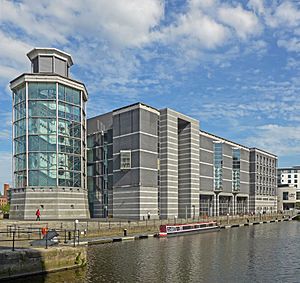
Abbey House Museum is in the old gatehouse of Kirkstall Abbey. It has recreated Victorian streets and exhibits about the abbey's history. Armley Mills Industrial Museum is in what was once the world's largest woollen mill. It has old industrial machines and railway engines. This museum also shows the first known moving pictures in the world, filmed in Leeds by Louis Le Prince in 1888.
Thackray Museum of Medicine tells the story of medicine, with topics like Victorian public health and old surgeries. It's in a former workhouse next to St James's Hospital. The museum was renovated and has won awards.
The Royal Armouries Museum opened in 1996. It holds the UK's national collection of arms and armour, which was moved from the Tower of London. It's one of the largest collections of its kind in the world. Thwaite Mills Watermill Museum is a restored 1820s water-powered mill on the River Aire. Nearby is the Leeds Museum Discovery Centre, which stores items not currently on display.
Universities and Colleges
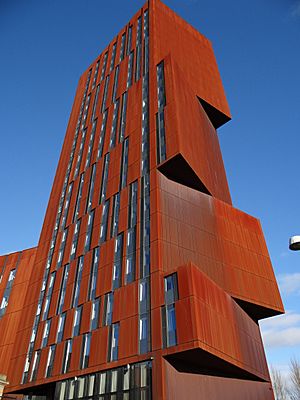
Leeds has five universities and the UK's fourth-largest student population. The universities include:
- The University of Leeds, founded in 1904.
- Leeds Beckett University, which became a university in 1992.
- Leeds Trinity University, which became a university in 2012.
- Leeds Arts University, founded in 1846, became a university in 2017.
- The University of Law, which moved to Leeds in 2014.
Other higher education places are Leeds Conservatoire, Northern School of Contemporary Dance, and University Centre Leeds.
The University of Leeds has about 31,000 students, and Leeds Beckett University has over 25,000 students. Leeds was voted the best UK university destination in a survey by The Independent newspaper.
Further education (after high school) in Leeds is provided by places like Elliott Hudson College, Leeds City College (with over 60,000 students), Leeds College of Building, and Notre Dame Catholic Sixth Form College.
Culture and Fun in Leeds
In 2018, Leeds started a five-year plan to boost its culture, leading to a big cultural celebration in 2023 called Leeds 2023.
Art in Leeds
Leeds Art Gallery, opened in 1888, has one of the best collections of 20th-century art outside London. It's free to visit. Next door, The Henry Moore Institute shows sculptures from all over the world.
The Tetley is a modern art centre in the old brewery building. The Gallery at 164 is an independent gallery showing various artists. The Stanley & Audrey Burton Gallery has art from the University Art Collection. Famous artists like Henry Moore and Damien Hirst studied at Leeds College of Art. Leeds city centre also has many statues and sculptures, plus a growing amount of street art and murals, like the UK's tallest mural, 'Athena Rising'.
Public Art in Leeds
Leeds has many public artworks, from traditional statues to modern pieces. These include works by Alfred Drury and Joseph Beuys. At Elland Road Stadium, there are two bronze statues celebrating former football manager Don Revie and team captain Billy Bremner.
Events and Festivals
The Leeds West Indian Carnival is the oldest West Indian Carnival in Western Europe. It attracts about 100,000 people over two days. The Leeds Festival, with big rock and indie music acts, happens every year in Bramham Park. The Leeds Asian Festival, also known as the Leeds Mela, is held in Roundhay Park.
Otley hosts annual events like the Folk Festival, Walking Festival, Carnival, and Victorian Christmas Fayre. Light Night Leeds happens every October, turning the city into an art display with light shows. Leeds Pride is an annual LGBT+ festival supported by the city council. Other festivals include Transform and Thought Bubble.
Film in Leeds
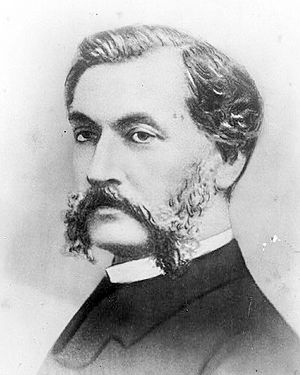
In October 1888, Louis Le Prince filmed the first known moving pictures, Roundhay Garden Scene and a Leeds Bridge street scene. This was years before other famous inventors. Today, the Leeds International Film Festival's short film competition is named after him. The 2015 documentary The First Film talks about Le Prince's important role.
Wordsworth Donisthorpe, also from Leeds, filmed the second-oldest surviving film. Both he and Louis Le Prince had strong connections to the Leeds Philosophical and Literary Society.
Leeds has a rich film culture. Besides the Leeds International Film Festival, the city has independent cinemas. The Cottage Road Cinema and Hyde Park Picture House have been showing films since 1912 and 1914, making them some of the oldest continuously running cinemas in the UK.
Literature in Leeds
Leeds has produced many famous writers, including author and playwright Alan Bennett. J. R. R. Tolkien, who wrote The Lord of the Rings, lived and taught in Leeds from 1921 to 1925. Leeds has also hosted the Leeds Lit Fest, a literature festival with talks and workshops. There are plans to create a National Poetry Centre in Leeds.
Important libraries in Leeds include:
- Leeds Central Library, a public library in the city centre.
- Leeds Library, a private library that is the oldest of its kind in the UK.
- A Boston Spa collection of The British Library, which includes a huge newspaper archive.
- A new city centre library by The British Library is planned to open in the future.
Parks and Green Spaces
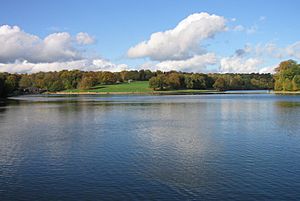
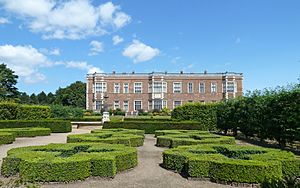
Leeds has many large parks and open spaces. Roundhay Park is the biggest park in the city and one of the largest city parks in Europe, with over 700 acres of parkland, lakes, and gardens.
Other parks include Beckett Park, Cross Flatts Park, Golden Acre Park, and the gardens of Harewood House. There are many smaller parks around the city, making up about 21.7% of Leeds's total area.
As part of a city renewal project, plans are being developed for Aire Park, a new 3.5-hectare park in the city centre. In 2023, the Monk Bridge viaduct was restored and opened as the Monk Bridge Viaduct Garden.
Live Music and Arts
Leeds is home to the Grand Theatre, where Opera North, the only national opera company outside London, is based. The City Varieties Music Hall is one of the few remaining music halls in the UK. It famously hosted performances by Charlie Chaplin and Harry Houdini.
Leeds is also home to Phoenix Dance Theatre and Northern Ballet Theatre. In 2010, these two companies moved into a special dance centre, the largest outside London.
The First Direct Arena opened in September 2013. This 13,500-seat stadium is a top venue for live music and sports. Concerts are also held at the O2 Academy and at the universities. Roundhay Park has hosted huge artists like Michael Jackson, Madonna, and Robbie Williams.
Many popular music acts started in Leeds, including Soft Cell, Kaiser Chiefs, and Corinne Bailey Rae. A public artwork called 'Leeds Song Tunnel' celebrates bands and musicians from Leeds.
On Valentine's Day 1970, the Who recorded their famous album Live at Leeds at the University of Leeds Refectory. This album is often called one of the best live rock recordings ever. Leeds is the only city outside London to have its own repertory theatre, ballet, and opera companies.
Nightlife and Fun
Leeds has a "Purple Flag" award, which means it's known for being an entertaining, diverse, safe, and enjoyable place at night. With over 200,000 students, Leeds is a major hotspot for nightlife in the UK. There are many pubs, bars, nightclubs, and restaurants, as well as places for live music.
Leeds has a well-known LGBT+ nightlife scene, mainly in the Freedom Quarter on Lower Briggate. The New Penny is one of the UK's longest-running LGBT+ venues. Near Millennium Square, there's a growing entertainment area with bars, restaurants, and a large outdoor screen. Millennium Square hosts big events like a Christmas market and concerts. It's next to the Mandela Gardens, opened by Nelson Mandela in 2001. Leeds also hosts an annual International Beer Festival in September.
Media in Leeds
Leeds is a big media hub. Yorkshire Post Newspapers Ltd, based in the city, publishes the daily The Yorkshire Post and the evening paper Yorkshire Evening Post. The Wetherby News and Wharfedale & Airedale Observer cover specific areas weekly. The two largest universities have student newspapers. Free publications include the Leeds Weekly News and the regional Metro.
BBC Television and ITV both have regional studios in Leeds. Channel 4 opened a new headquarters at the Majestic in 2020. ITV Yorkshire broadcasts from the Leeds Studios. There are also independent film production companies.
Radio stations broadcasting from Leeds include BBC Radio Leeds, Hits Radio West Yorkshire, and Capital Yorkshire. Many communities in Leeds also have their own local radio stations. Leeds has a local television station called Leeds TV, which started in 2014 as Made in Leeds.
Sports in Leeds
Leeds has teams in all the major national sports. Leeds United F.C. is the city's main football club. They play at the 37,890-seat Elland Road Stadium. They were promoted to the Premier League in 2019–20 but were relegated back to the Championship in 2022–23. Other football clubs include Guiseley AFC, Farsley Celtic, and Garforth Town.
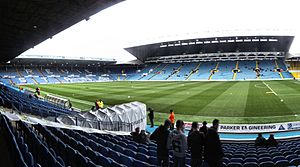
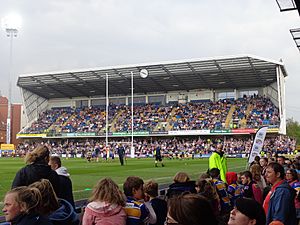
Leeds Rhinos are the most successful rugby league team in Leeds. They play their home games at Headingley Rugby Stadium. They won the Super League three seasons in a row, earning their fourth title in 2009. Other rugby league teams include Hunslet, East Leeds, and Oulton Raiders.
Leeds Tykes are a rugby union team that also used to play at Headingley. Otley RUFC and Morley RFC are other rugby union clubs in the area.
Headingley Cricket Stadium is home to Yorkshire County Cricket Club, the most successful cricket team in England. Leeds City Athletic Club competes in national athletics leagues.
Leeds has many field hockey clubs, including Leeds Hockey Club and Leeds Adel Carnegie Hockey Club. The City of Leeds Synchronised Swimming Club trains at the John Charles Centre for Sport and competes nationally and internationally.
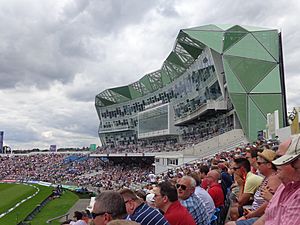
The city has excellent sports facilities, including the Elland Road football stadium, which hosted games during the 1996 European Football Championship. The Headingley Carnegie Stadiums are famous for both cricket and rugby league. The John Charles Centre for Sport has an Olympic-sized swimming pool. Other facilities include the Leeds Wall (for climbing) and Yeadon Tarn sailing centre. In 1929, the first Ryder Cup of Golf in Britain was held at Moortown Golf Club. Wetherby Racecourse hosts horse racing.
The 2014 Tour de France Grand Départ (the start of the famous cycling race) took place from the Headrow in Leeds city centre. Leeds is also known for its divers. The City of Leeds Diving Club has trained many Olympic athletes, including Jack Laugher and Chris Mears, who won Great Britain's first Olympic gold medal in diving in 2016. Leeds has an ice hockey team, the Leeds Knights, who play at the Planet Ice Arena.
Leeds has a strong climbing and mountaineering community. The Yorkshire Ramblers' Club, England’s second oldest mountaineering club, was founded in Headingley in 1892. The UK’s first artificial climbing wall was built at the University of Leeds in 1964. Leeds has hosted national climbing championships.
Sports Teams in Leeds
| Club | Sport | League | Venue | Location | Formed | Top flight championships |
|---|---|---|---|---|---|---|
| Yorkshire CCC | Cricket | County Championship | Headingley Stadium | Headingley | 1863 | 33 |
| Leeds Rhinos | Rugby league | Super League | Headingley Stadium | Headingley | 1870 | 11 |
| Leeds United | Football | EFL Championship | Elland Road Stadium | Beeston | 1919 | 3 |
| Hunslet | Rugby league | League 1 | John Charles Centre for Sport | Hunslet | 1883 | 2 |
| Guiseley | Football | Northern Premier League | Nethermoor Park | Guiseley | 1909 | 0 |
| Farsley Celtic | Football | National League North | Throstle Nest Stadium | Farsley | 1908 | 0 |
| Leeds Knights | Ice hockey | National Ice Hockey League | Planet Ice Leeds | Beeston | 2019 | 0 |
Religions in Leeds
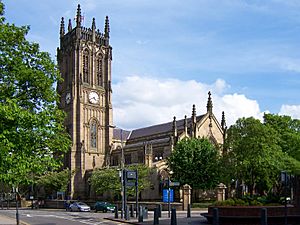
Religion in Leeds (2021) Christianity (42.3%) No religion (40.2%) Islam (7.8%) Sikhism (1.2%) Hinduism (1.1%) Judaism (0.8%) Buddhism (0.4%) Other religion (0.4%) Not stated (5.8%)
Most people in Leeds identify as Christians. Leeds does not have its own Church of England cathedral, but it is part of the Anglican Diocese of Leeds. The most important Anglican church is Leeds Minster. Leeds also has a Roman Catholic Cathedral. Many other Christian groups are present in Leeds.
The number of Muslims in Leeds is slightly higher than the national average. You can find Mosques throughout the city, serving Muslim communities in areas like Chapeltown and Harehills. The largest mosque is Leeds Grand Mosque.
The Sikh community has gurdwaras (temples) across the city. The largest is in Chapeltown. There's also a colourful annual procession called the Nagar Kirtan in Millennium Square to celebrate Vaisakhi, the Sikh New Year.
Leeds has the third-largest Jewish community in the UK, after London and Manchester. Areas like Alwoodley and Moortown have many Jewish residents, and there are eight active synagogues. The Hindu community has a temple in Hyde Park.
Various Buddhist traditions are also found in Leeds. The Buddhist community celebrates the festival of Wesak in May. There is also a community of the Baháʼí Faith in Leeds.
Public Services in Leeds
Water and sewage services in Leeds are provided by Yorkshire Water. Leeds City Council aims to get more renewable energy from wind power. There are plans for wind turbines near Micklefield.
The West Yorkshire Police look after safety in Leeds. Their main office is at Elland Road. Fire and rescue services are provided by the West Yorkshire Fire and Rescue Service, with several fire stations across the city.
NHS health services are provided by the Leeds Teaching Hospitals NHS Trust. Leeds General Infirmary (LGI) is a historic hospital in the city centre. St James's University Hospital, known as "Jimmy's," is Europe's largest teaching hospital. Other NHS hospitals include Chapel Allerton Hospital and Seacroft Hospital.
West Yorkshire Joint Services provides various services like archives and materials testing for Leeds and other West Yorkshire areas. Leeds City Council manages over 50 public libraries, including the main Central Library on the Headrow.
Freedom of the City of Leeds
The Freedom of the City is a special honour given to individuals, military units, or groups who have done great things for Leeds.
Individuals Honoured
- Field Marshal Douglas Haig, 1st Earl Haig: 1920
- Admiral of the Fleet David Beatty, 1st Earl Beatty: 1922
- David Lloyd George: 1922
- Edward Wood, 1st Earl of Halifax: 1923
- Stanley Baldwin: 1925
- H. H. Asquith: 1925
- Berkeley Moynihan, 1st Baron Moynihan: 1926
- Sir William Middlebrook: 1926
- Sir Edward Brotherton: 1926
- Philip Snowden, 1st Viscount Snowden: 1930
- Arthur Greenwood: 1930
- Mary, Princess Royal and Countess of Harewood: 1932
- H. V. Evatt: 1943
- Sir Winston Churchill: 1958
- Major James Milner, 1st Baron Milner of Leeds: 1967
- Nelson Mandela: 2001
- Dame Fanny Waterman: 2004
- Jane Tomlinson: 2005
- Alan Bennett: 2006
- James Heselden: 2011 (Awarded after his death)
- Beryl Burton: 2014 (Awarded after her death)
- Rob Burrow: 2022
- Kevin Sinfield: 2022
Military Units Honoured
- HMS Ark Royal, RN: 1941
- RAF Church Fenton: 1971
- HMS Ark Royal, RN: 1973
- 5th Battalion The Rifles: 2009
- 4th Battalion The Parachute Regiment: 2020
- Leeds Rifles
- Leeds Pals
- 51st (2nd Yorkshire West Riding) Regiment of Foot
- Leeds Volunteer Corps
Groups Honoured
- Leeds United FC 1967–74: 2019
See also
 In Spanish: Leeds para niños
In Spanish: Leeds para niños


